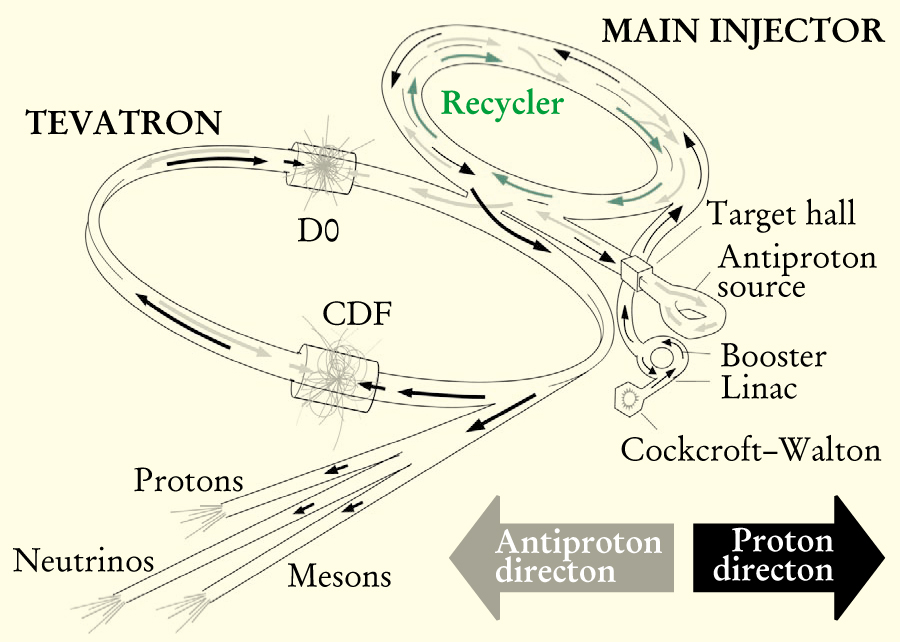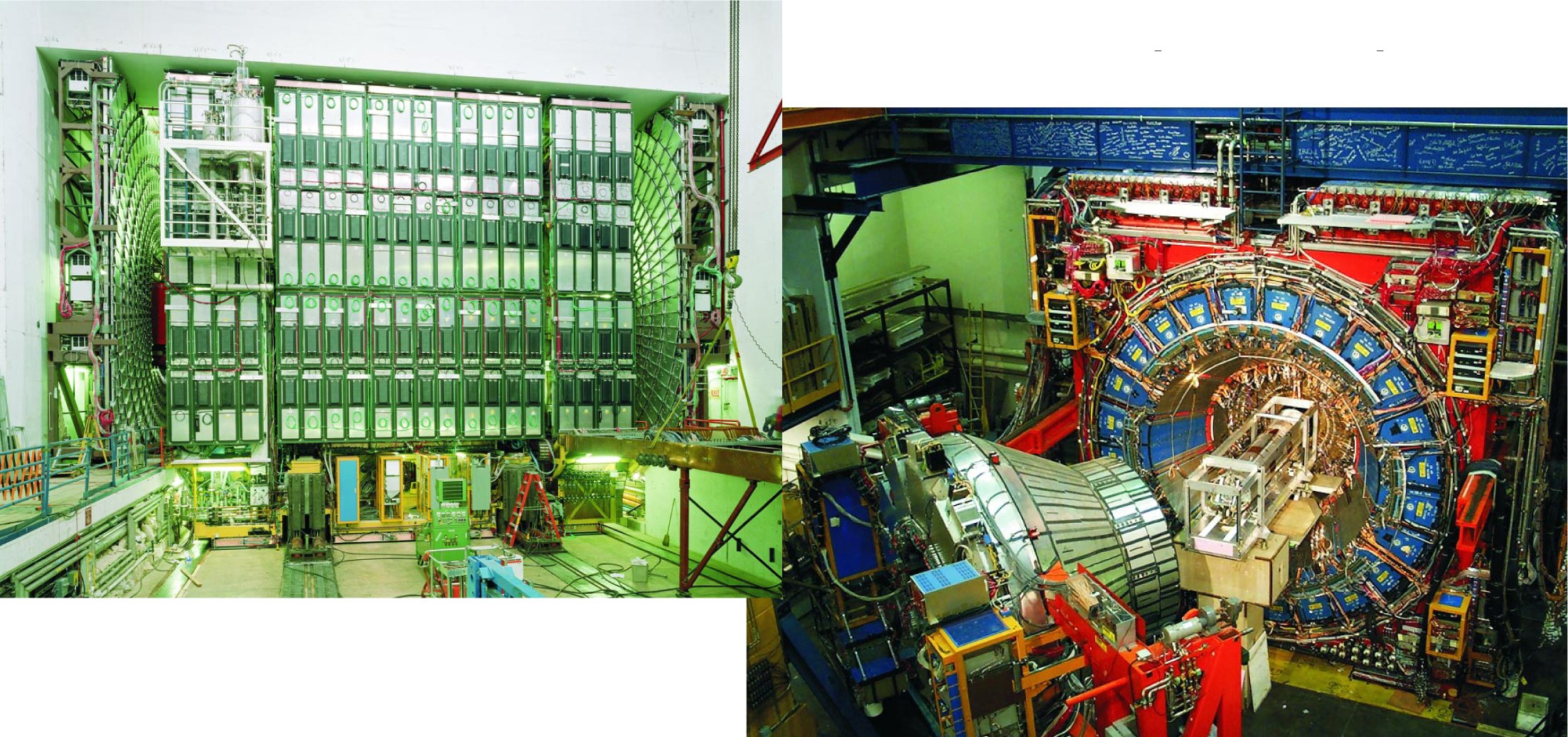Slowly but Steadily, Fermilab Pushes the Upgraded Tevatron toward Its Design Goals
DOI: 10.1063/1.1496363
Fermilab has a window of opportunity. Its 2-trillion-electron-volt proton–antiproton Tevatron collider is, at present, the world’s highest-energy particle accelerator—the only one with a shot at finding the elusive Higgs boson or direct indications of supersymmetry. But it will hold on to its monopoly only until the completion of CERN’s 14-TeV Large Hadron Collider, which is better poised to make such findings. The LHC is currently scheduled to turn on in 2007, although it is running into some problems (see Physics Today, May 2002, page 30
To take full advantage of its opportunity, in the 1990s Fermilab undertook a $260-million upgrade of the Tevatron, primarily to increase the collider’s luminosity—the event rate per unit interaction cross section. The Tevatron upgrade was designed to produce an initial fivefold increase in luminosity. The addition of an antiproton recycler more than a year from now should boost the luminosity by another factor of 2–2.5. The increased event rate, coupled with a slightly higher collision energy, is expected to render the experiments more sensitive to rare processes like new particle production.
Alas, over a year into its inaugural run, the upgraded Tevatron is producing events at a disappointingly low rate. Only recently has its average luminosity reached 1.6 × 1031 cm−2 s−1, a value routinely achieved before the upgrade. Fermilab scientists had hoped to be at 3–4 × 1031 cm−2 s−1 by now and at the first-stage design goal of 8 × 1031 cm−2 s−1 by the end of this year.
It’s not the first time that an accelerator project has been slow to reach its potential. Moreover, several observers note, it’s harder to make an existing accelerator facility perform well beyond its original design than to build a totally new one. Still, with the upgrade schedule lagging, everyone involved is hearing the loud ticking of the clock, and the hundreds of experimenters from around the world who are collaborators at the two main particle detectors, called CDF and D0, are frustrated at the trickle of data they are getting. “We had hoped to have significant results to announce at a summertime conference; instead we’ll be making a progress report,” said Alfred Goshaw, a CDF spokesperson.
The particle physicists who spoke to Physics Today all said how important it was for the Tevatron upgrade to succeed, for the benefit of the worldwide high-energy physics community. A number of them pointed out that Fermilab had undertaken a very challenging project, so that it was not surprising that the lab is encountering some problems. Unfortunately, the problems have been severe and the progress has been slow. By now, concur most observers, the needed attention and personnel are being focused on these problems. Alan Jackson of Lawrence Berkeley National Laboratory, who participated in a recent annual review of Fermilab for the Department of Energy, said he had seen a significant improvement in the short time between the DOE review in mid-March and the High Energy Physics Advisory Panel meeting in late April.
The upgrade
Figure 1 shows the accelerator complex. Bunches of protons from the booster enter the newly built main injector, which accelerates them to 120 GeV. From there, protons are directed almost continuously onto a target, where their impacts produce antiprotons. The antiprotons build up in the antiproton accumulator (part of the antiproton source shown in the figure). This operation is interrupted approximately once per day, when the protons are transferred directly from the main injector to the Tevatron. The antiprotons are then sent to the main injector, boosted in energy, and directed to the Tevatron, where both protons and antiprotons are accelerated to nearly 1 TeV. In the Tevatron, the antiparticles move in countercirculating helical paths, which overlap in two interaction regions where the CDF and D0 detectors are positioned. After about 24 hours of collisions, the beam particles are sent to the beam dump. Once the recycler is completed, however, the antiprotons that do not collide (95% of the original beam) will be diverted to the recycler loop, decelerated, and prepared for reinjection into the Tevatron ring.

Figure 1. Schematic of The Upgraded Tevatron. Protons (dark arrows) from the Cockcroft–Walton generator are sent to the booster, accelerated in the main injector, and focused onto a target to produce antiprotons (light arrows), which build up in an accumulator that’s part of the antiproton source. Periodically, protons from the main injector are sent to the Tevatron, raised to their final energy, and stored. When the antiprotons build up, they too are sent to the main injector and Tevatron, orbiting in a direction opposite to the protons. A recycler, now being built in the main injector tunnel, will capture and reuse uncollided antiprotons (green arrows).
(Figure courtesy of Fermilab.)

This scheme is no different from that of the Tevatron before the upgrade, a period called Run I. But now, in Run II, the particle bunches are flying through these various components at a higher rate: 36 bunches of each type of particle—protons and antiprotons—are orbiting in the Tevatron at any given time. Run I had 6 bunches at a time. The number of particles in each bunch is roughly the same as before. With this design, the number of collisions between particle bunches is increased in Run II, but the number of events per collision is kept nearly constant.
Having more bunches requires more protons and antiprotons. Thus, Fermilab built the new main injector, which can put more protons onto the target for antiproton production. To handle the higher fluxes, the lab also significantly modified the Tevatron and antiproton accumulator. Finally, the lab utilized monetary savings in the main injector construction project to build the recycler. Stephen Peggs of Brookhaven National Laboratory, who served on a Universities Research Association visiting committee that reviewed progress at the Tevatron in April, commented that the lab is “pushing the envelope to make things happen. They have some very exciting, avant-garde things going on there.”
No showstoppers
Where do the problems lie? Physicists in the lab’s beams division can’t point a finger at any single weakness in the system. Rather, they have uncovered a number of problem areas—none of them fatal. The string of problems gets compounded as the particles are transferred from one ring to another in a series of steps to achieve the final high-energy beams. As pointed out by Steve Holmes, associate director for accelerators, “The Tevatron is a highly connected system; a change anywhere gets magnified.” To solve the problems, beam physicists have to tackle many fronts at once. The hope is that an improvement in one part of the complex chain will lead to additional improvements down the line.
The biggest problem is the loss of antiprotons during their long journey from the accumulator to full energy in the Tevatron. Holmes reported that they are currently losing about three-fifths of the antiprotons. The transfer efficiency of these particles from the main injector into the Tevatron is especially disappointing. Beam experts at the lab have made a number of corrections, each of which netted a 20–25% improvement, but the current luminosity is still roughly half of what it should be at this stage.
One source of the antiproton loss is the high emittance of the antiproton beam in the accumulator. (Emittance is a measure of the beam’s size and angular spread.) As Physics Today went to press, the beam physicists were about to undertake a reconfiguration of the optics and cooling systems in the accumulator, which they hoped would cut the emittance in half.
Yet another big issue is the long-range beam–beam interaction within the Tevatron. The proton and antiproton bunches move in opposite directions along intertwined helical paths that are designed to keep the bunches as far apart as possible, except at the two interaction regions where they intentionally cross. Despite attempts to separate the protons and antiprotons, the beam interactions seem to be stronger than had been calculated.
Staff turnovers
The problems are not all technical, admits Fermilab director Michael Witherell. He acknowledges the difficulty of tackling all the problems simultaneously, given the demands on the limited number of experienced accelerator physicists in the beams division. The lab management has begun bringing in physicists from other divisions of the lab to address specific problems on which they have relevant expertise. And offers of help are pouring in from accelerator labs and university physics departments, as well.
Like many other accelerator complexes, Fermilab is finding it increasingly difficult to hold on to talented accelerator physicists because the demand greatly exceeds the supply. Witherell noted that many beam physicists are lured away from particle colliders to work on medical accelerators, synchrotron radiation facilities, or nuclear physics accelerators. As the Tevatron was being upgraded, a number of beam physicists from Fermilab were attracted to the Spallation Neutron Source, a state-of-the-art machine being built at Oak Ridge National Laboratory. And some Fermilab scientists have retired. While Fermilab was able to fill the vacant positions with very talented individuals, said Witherell, “the loss of experience can’t be fully compensated by hiring young people, no matter how bright.” Witherell adds that, although the necessary attention was focused on the construction and commissioning of the main injector, not enough thought was given to the kind of people they’d need to have on board to carry out the tough job of commissioning the rest of the complex.
As to finances, Peter Rosen, associate director for DOE’s Office of High Energy and Nuclear Physics, said, “We have realigned the ‘02 budget to give Fermilab its best shot to go after the Higgs, although we had to cut back on other parts of high-energy physics.” Still, the increase in DOE funds just accounts for inflation. Witherell has further redirected funds within Fermilab this year to give the accelerator division a 15% increase in its normal budget for operations and improvements, at the expense of other laboratory programs.
Impact on experimenters
The two major detector groups at Fermilab, CDF and D0, undertook major upgrades in parallel with that at the Tevatron to enable the instruments to handle collisions at a much higher rate. That meant adding new detector elements, trigger systems, and electronics. In addition, both detector groups improved their capability to do B-meson physics—the study of interactions and decays involving the bottom quark.
The detector groups plan, in the short term, to make precise measurements of known particles such as the top quark and to further probe the predictions of the standard model. In the longer term, at the highest luminosities, they will look for new physics. They hope, for example, to uncover the Higgs boson, see signs of supersymmetry, find evidence of new strong forces, or even detect extra dimensions of spacetime.
Both groups worry about how the delay in Run II will affect students, many of whom had planned to write theses based on the data. Fermilab’s John Womersley, the spokesman for D0, said that some of the students working with the collaboration have had to write theses on somewhat contrived topics, describing the potential for future analyses rather than using real data. And Goshaw noted that some students have gone to other projects. The delay also impacts the finances of experimental groups participating in the detector collaborations, which often need positive results to secure renewed funding.
Peggs expressed cautious optimism concerning the situation at Fermilab: “I think they’ll reach their goal, but it will take time, patience on the part of users, and systematic organization.”

Figure 2. Particle Detectors D0 (left) and CDF (right) are successfully taking data at the upgraded Tevatron. They have been revamped to accept particle bunches at a higher rate.
(Photos courtesy of Fermilab.)

